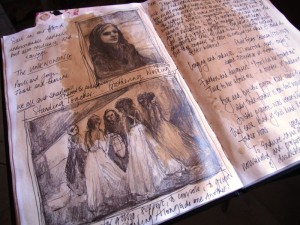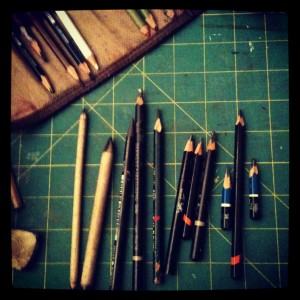One of the myths about being an artist is that hours upon endless hours are spent at the easel painting away with no thought to time or the passing of the day. I can tell you that really, this could not be further from the truth. In an average I spend a lot less time painting than it might appear and guess what? I am okay with that!! The way I work, a lot of my time is spent developing ideas, sketching, sorting materials, dreaming, writing and so on and so on. It makes it a much more enjoyable process, really it does!
If you read my series on ‘Getting to the easel’ you will realise that there are so many other things that I do in my working week in the studio. I know I have more time than many people but I do believe that even with very limited time it is possible to still commit to creating art in whatever time you do have.

Sketchbook pages for We all cast shadows 2014
On this post on ‘facing the blank page‘ I asked you to kindly answer a few questions and I was overwhelmed at the feedback that I received via email, website comments and blog comments. As someone who has struggled with every area of creating art possible over the 6 or so years I have been a working artist I had an idea of the main areas I thought would come up when discussing the struggles and barriers in creating art. I was not surprised in the least to hear that ‘lack of time’ is one of the main struggles we all face in a modern world that demands so much of our time.
When thinking of creating art we often put an expectation on ourselves that we can only create work in big blocks of time but over the years I have learned that one of the key things is in preparation. There are many things that you can do in 10 minutes here and there that will mean when you do have a couple of indulgent hours at the easel your time is much more productive and the pressure is lessened.
So here are a few of the things I do whenever I have a moment (whether it be 10 minutes before leaving for work, or 15 minutes when I get home) to ensure that my dedicated time at the easel flows more easily when I have full painting days or a block of a couple of hours to paint.
1. Cut paper to various sizes so that I have a ready stock of the sizes I work with the most.
2. Make sure I have a stack of boards with paper ready stretched ready for gesso. (I am going to do a post soon on how to stretch paper for painting on soon.)
3. Gesso paper ready for painting
4. Make sure my brushes are clean and conditioned ready for working with.
5. Pre mix colours on my stay wet palette if I know I am going to be having a painting session in the next few days.
6. Daily sketches – most of the sketches I do only take 10-15 minutes and it ensures I have a plethora of ideas to work from.
7. Clean my workspace so I am good to go when I get to the studio.
8. Print off any photographs I have filed away on my computer and put them into photo albums so they are all sorted out for me to draw on when I am looking for inspiration.
9. Print off images for collage and mixed media pieces. (I have a selection of copyright free images that I use time and time again and always have a box with a selection of those ready to go)
10. Check my paint stock or other materials to make sure that I don’t find I have run out of something when I am in work mode.
11. Sharpen pencils, check pens work, make sure the water in my pot is clean for painting, fill up my teabag box in my tea-making corner in my studio.
12. If I am watching TV in the evening I am usually flicking through research imagery or taking notes or sketching at the same time – keeps my ideas flowing so that I already have ideas when I get to a painting day. Or I watch instructional videos on Youtube or read books on creativity, art and inspiration.
Very few of these things take more than 10 minutes and even on days where I am out of the house for 9 or 10 hours I can usually do one thing before leaving for work and one thing when I get home. Nothing feels like work. I enjoy doing all of these things, they give me great pleasure and help me feel like I am taking small steps towards working on my dream without feeling the pressure of hours and hours of struggling to fit everything in. Since implementing these small steps I have felt a lot less pressure when it comes to completing artwork and enjoy it so much more. Art isn’t work – it is a lifestyle!
PS Thank you so, so much for your wonderful feedback and excitement regarding the release of my very first e-course. It is very nerve-wracking to put myself out there in this way but I do feel I have good things to share. I have felt a huge release and development in the last year or so in the way that I create art and am far more gentle on myself than I used to be. I cannot wait to share what I know with those of you who are able to take the course. Remember that you can sign up to the mailing list on the bottom of the E-course page here for more information and I am adding to the page a little every day. Registration opens Monday 3rd February.


Recent Comments